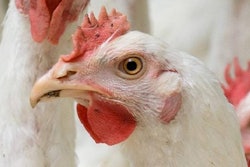
In the last week, new outbreaks of highly pathogenic avian influenza (HPAI) have occurred in commercial poultry in Bhutan, Saudi Arabia, South Korea and Taiwan, and while surveillance of wild birds has revealed one form of the virus continues to circulate in the wild bird population in Europe.
Official reports to the World Organisation for Animal Health (OIE) in the last week show that the most new outbreaks of HPAI in poultry have been confirmed in Taiwan. More than 30,000 birds were involved in the latest six outbreaks, which were linked to the H5N2 virus subtype. Five of these were in meat ducks on farms in the counties of Yunlin and Pingtung, where intensive surveillance has been undertaken. The other cases were in native chickens, where suspicious signs were observed at post-mortem at a Taipei slaughterhouse. Each site has been subjected to appropriate depopulation, cleaning and disinfection, and intensive surveillance is on-going.
South Korea has reported a further three outbreaks of HPAI involving the H5N6 virus variant, bringing the country’s total so far this winter to 22, according to the Yonhap news agency. These most recent cases were in laying hens, with more than 543,000 birds lost to the disease through mortality or destruction. Two of the affected farms were in Gyeonggi province, and the other in South Chungcheong. An immediate 48-hour ban on poultry movements were imposed nationwide (excluding Jeju island).
H5N8 HPAI has been reported in two recent outbreaks in poultry in Saudi Arabia. The latest cases involved more than 29,000 birds at farms in the governorates of Qassim and Al-Quwayiyah, reports Gulf Business. As of March 1, there had been 22 outbreaks of the disease in the Kingdom since December of 2017. These have resulted in almost 158,000 birds lost to mortality, and a further 1.786 million slaughtered to stop further spread of the disease.
Bhutan’s animal health agency has reported to the OIE a second outbreak of HPAI in poultry caused by the H5N1 virus. More than 600 birds were lost to the disease through death or destruction at a farm in Samtse, a region in the south-west of the country that borders India.
A further 23 dead wild birds at seven locations in Itami city in Japan’s Hyogo prefecture have tested positive for the H5N6 HPAI virus, according to the official OIE report.
Israel has reported to the OIE its previous HPAI situation resolved. The H5N8 virus has not been detected since one wild bird was found dead in Jerusalem in January this year.
Europe: HPAI detected in more wild birds
Surveillance of sick and dead wild birds has revealed the presence of the H5N6 HPAI virus on the European continent.
After a brief absence from Germany, the virus has been detected in a small flock of 73 rare and endangered species in the northern state of Schleswig-Holstein. The cases were on Süderoog, one of a group of islands in the north Frisian Wadden Sea known as a bird reserve.
The Dutch authorities have reported to the OIE the same virus in two more wild birds, one each in the south-western province of Zeeland, and in Groningen in the north-east of The Netherlands.
For the first time this year, the H5N6 HPAI virus has been detected in a wild bird in Northern Ireland—in a wild buzzard in County Antrim.
In France, the number of outbreaks of low pathogenic avian influenza (LPAI) of the H5N3 has risen to 58. Latest to be affected was a flock of ducks in Lot-et-Garonne in the south-west of the country. They were kept at a farm that was within one kilometer of a farm where the same virus was recently detected.
Russia’s animal health agency has declared to the OIE that it has resolved a previous HPAI situation linked to the H5N2 virus variant. Just one outbreak of the disease was confirmed—in a large commercial flock in Kostroma oblast in the Central Federal district at the end of 2017.
Africa: Relief over Ghana’s recent outbreak low-pathogenic
Earlier this year, OIE was informed by the veterinary authority in Ghana of a first outbreak of HPAI in poultry caused by the H9N2 virus subtype. It now appears that the virus was a low-pathogenic form of the virus, according to ProMED.
“The reporting, by Ghana, of the case demonstrates transparency and deserves to be commended,” commented ProMED. “It is relieving indeed to note that an alarming reassortment of the widespread H9N2 strain into high pathogenicity has not taken place.”
While the South African authorities have not officially reported any new outbreaks of HPAI in commercial poultry to the OIE, the Parliament’s agriculture committee has voiced concerns over the spread of the virus to endangered African penguins, Business Live reported last week. Particularly at risk are the birds on Boulders Beach in Western Cape Province.

















